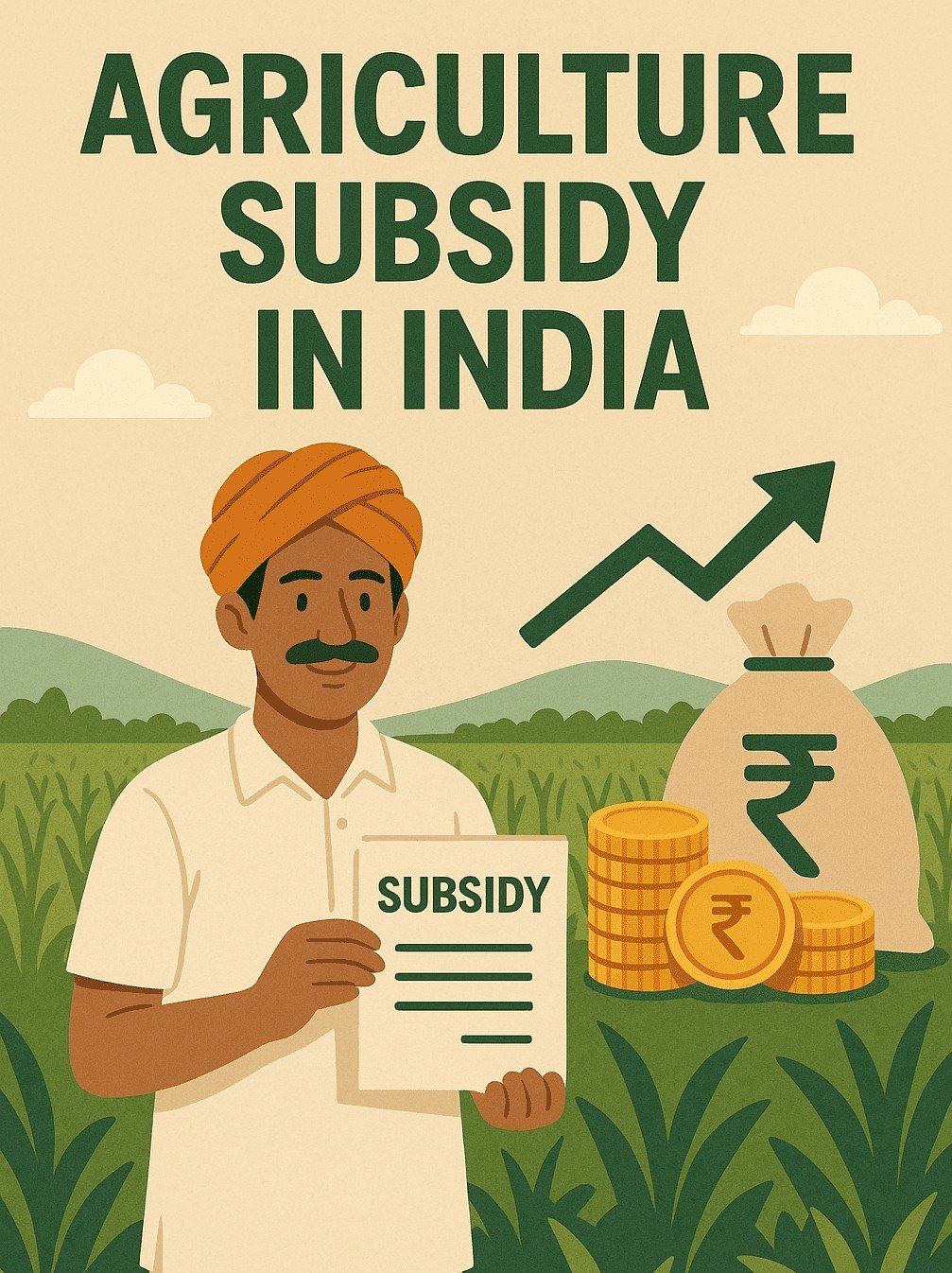Benefits
Boost Your Farm’s Future: Complete Guide to Agricultural Subsidies in India

{ Agriculture is the backbone of India’s economy, providing livelihood to nearly 60% of the population. To empower farmers, boost productivity, and ensure food security, the Indian government offers a variety of agricultural subsidies. These subsidies reduce input costs and promote sustainable farming practices. }
In this blog, we’ll explore the different types of agriculture subsidies in India, how they benefit farmers, and answer some commonly asked questions.

What is an Agriculture Subsidy?
An agriculture subsidy is financial support provided by the government to farmers to make farming more affordable and profitable. These subsidies can come in the form of direct cash transfers, discounted inputs (like fertilizers, seeds, and power), or support prices for crops.
Major Types of Agriculture Subsidies in India
1. Fertilizer Subsidy
The fertilizer subsidy is one of the most significant subsidies in India. Under this scheme, farmers receive fertilizers like urea, DAP (Di-Ammonium Phosphate), and MOP (Muriate of Potash) at reduced rates.
- How it works: The government pays the difference between the cost of production/import and the retail price.
- Benefit: Ensures access to essential nutrients for crops at affordable prices.
2. Seed Subsidy
High-quality seeds are crucial for improving crop yield. The seed subsidy is provided to promote the use of certified seeds among farmers.
- Implemented by: State governments and the Indian Council of Agricultural Research (ICAR).
- Benefit: Encourages the use of high-yielding, pest-resistant seed varieties.
3. Irrigation Subsidy
Water is a key input in agriculture. To promote water-efficient methods, the government provides irrigation subsidies through schemes like:
- Pradhan Mantri Krishi Sinchayee Yojana (PMKSY): Promotes micro-irrigation systems like drip and sprinkler irrigation.
- Benefit: Saves water, improves productivity, and ensures year-round farming.
4. Power Subsidy
Many states offer power subsidies to farmers for operating pumps and irrigation systems.
- Mode: Free or highly subsidized electricity for agricultural purposes.
- Controversy: While beneficial, this subsidy can lead to groundwater over-extraction.
5. Crop Insurance Subsidy
To protect farmers from unpredictable weather and market fluctuations, the government offers subsidized crop insurance under the Pradhan Mantri Fasal Bima Yojana (PMFBY).
- Coverage: Natural calamities, pests, and diseases.
- Benefit: Ensures income security even during crop failure.
6. Credit Subsidy
Access to low-interest credit is essential for small and marginal farmers. The Interest Subvention Scheme offers credit subsidies by lowering interest rates on agricultural loans.
- Institutions involved: NABARD, cooperative banks, RRBs.
- Benefit: Encourages timely borrowing and investment in farming.
7. Machinery and Equipment Subsidy
To promote mechanization, the government provides subsidies on the purchase of equipment like tractors, harvesters, and seed drills.
- Under schemes like: Sub-Mission on Agricultural Mechanization (SMAM).
- Benefit: Reduces manual labor and improves efficiency.

Empowering farmers through government subsidies — agricultural support driving rural prosperity in India.
Frequently Asked Questions (FAQ)
Q1. Why are agriculture subsidies important in India?
A: Agriculture subsidies reduce the financial burden on farmers, increase productivity, and ensure national food security. They also help in stabilizing rural incomes and encouraging modern farming practices.
Q2. Who is eligible to receive agricultural subsidies?
A: Most subsidies are targeted at small and marginal farmers. Eligibility depends on the specific scheme. Typically, a valid farmer ID, land ownership, and Aadhaar linkage are required.
Q3. How can farmers apply for subsidies?
Applying for agriculture subsidies in India has become easier with the digitization of government services. Most central and state schemes now offer online application facilities, reducing the dependency on middlemen and speeding up the process.
Here’s a step-by-step guide to help farmers apply for subsidies effectively:
Step 1: Identify the Relevant Subsidy Scheme
Start by identifying the subsidy scheme you are eligible for. Different subsidies are available under central and state government schemes. Common examples include:
-
Pradhan Mantri Fasal Bima Yojana (PMFBY) – for crop insurance
-
Pradhan Mantri Krishi Sinchayee Yojana (PMKSY) – for irrigation
-
Sub-Mission on Agricultural Mechanization (SMAM) – for machinery
-
Paramparagat Krishi Vikas Yojana (PKVY) – for organic farming
- Pradhan Mantri Kisan Samman Nidhi (PM-KISAN) – for farmers
Check eligibility based on your landholding size, type of crop, geographical location, and farming practices.
Step 2: Gather Required Documents
Before applying, collect the following commonly required documents:
-
Aadhaar card (mandatory for most schemes)
-
Land ownership or tenancy proof (Record of Rights or Patta)
-
Bank passbook copy (for Direct Benefit Transfer)
-
Recent passport-size photo
-
Soil health card (for input-related schemes)
-
Mobile number linked with Aadhaar
-
Crop sowing certificate (for insurance claims)
Some state-specific schemes may also require caste or income certificates.
Step 3: Register on the Respective Online Portal
Many subsidy schemes can be accessed via government portals:
You may need to create an account using your Aadhaar and mobile number to access services.
Step 4: Fill in the Application Form
Once registered:
-
Select the scheme you want to apply for.
-
Fill in accurate details about your land, crop, and bank account.
-
Upload scanned copies of the required documents.
-
Review your application before submission.
Many portals offer a preview option before finalizing.
Step 5: Submit and Track Your Application
After submission:
-
Note your application/reference number for future tracking.
-
Most portals offer a “Track Application” feature to check your status.
-
If physical verification is required (like for machinery subsidy), a field officer may visit your farm.
Step 6: Receive Subsidy via DBT
If your application is approved:
-
The subsidy amount is directly credited to your linked bank account through Direct Benefit Transfer (DBT).
-
You may receive an SMS or email notification once the payment is processed.
Tips for a Successful Application
-
Always double-check eligibility criteria before applying.
-
Ensure your Aadhaar and bank account are linked and active.
-
Maintain a copy of all submitted documents and receipts.
-
Follow up with your local agriculture officer if there are delays or discrepancies.
Q4. Are subsidies available for organic farming?
A: Yes. The government promotes organic farming under schemes like Paramparagat Krishi Vikas Yojana (PKVY) and Mission Organic Value Chain Development (MOVCDNER), which include financial support for organic inputs and certification.
Q5. What is the future of agricultural subsidies in India?
A: The focus is shifting towards smart subsidies—those that encourage sustainability, digital tracking, and direct benefit transfers. The goal is to ensure that subsidies are more targeted, efficient, and less prone to misuse.
Conclusion
Agricultural subsidies in India play a pivotal role in uplifting farmers and strengthening the rural economy. From fertilizers to insurance, these subsidies cover almost every aspect of farming. However, there’s a growing need for reforms to make them more targeted, transparent, and technology-driven.
By understanding the various subsidy schemes, farmers can make informed decisions and take full advantage of the support available to them.












